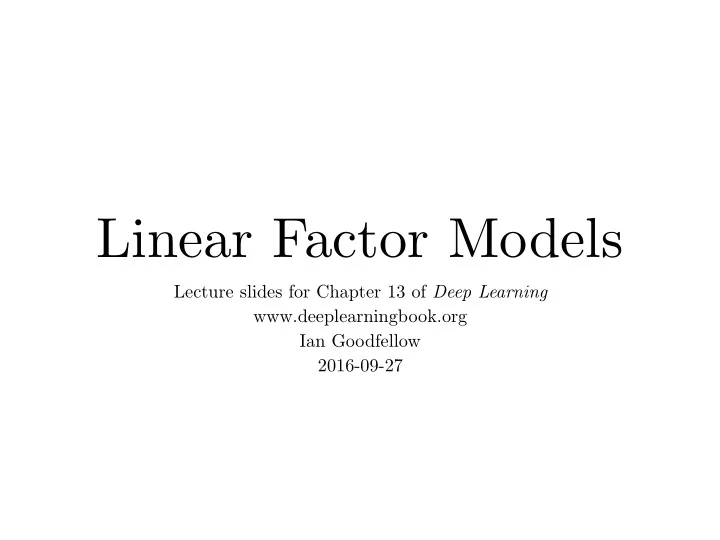

Linear Factor Models Lecture slides for Chapter 13 of Deep Learning www.deeplearningbook.org Ian Goodfellow 2016-09-27
Linear Factor Models h 1 h 1 h 2 h 2 h 3 h 3 x 1 x 1 x 2 x 2 x 3 x 3 x = W h + b + noise x = W h + b + noise Figure 13.1 (Goodfellow 2016)
Probabilistic PCA and Factor Analysis • Linear factor model • Gaussian prior • Extends PCA • Given an input, yields a distribution over codes, rather than a single code • Estimates a probability density function • Can generate samples (Goodfellow 2016)
Independent Components Analysis • Factorial but non-Gaussian prior • Learns components that are closer to statistically independent than the raw features • Can be used to separate voices of n speakers recorded by n microphones, or to separate multiple EEG signals • Many variants, some more probabilistic than others (Goodfellow 2016)
Slow Feature Analysis • Learn features that change gradually over time • SFA algorithm does so in closed form for a linear model • Deep SFA by composing many models with fixed feature expansions, like quadratic feature expansion (Goodfellow 2016)
Sparse Coding p ( x | h ) = N ( x ; W h + b , 1 β I ) . (13.12) p ( h i ) = Laplace( h i ; 0 , 2 λ ) = λ 4 e − 1 2 λ | h i | (13.13) λ || h || 1 + β || x − W h || 2 = arg min (13.18) 2 , h (Goodfellow 2016)
Sparse Coding Samples Weights Figure 13.2 (Goodfellow 2016)
Manifold Interpretation of PCA e 13.3: Flat Gaussian capturing probability concentration near a low-dimen Figure 13.3 (Goodfellow 2016)
Recommend
More recommend